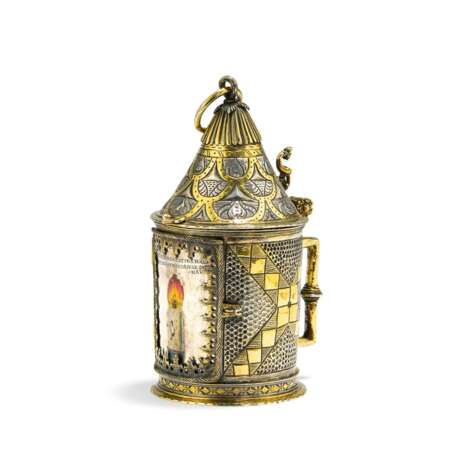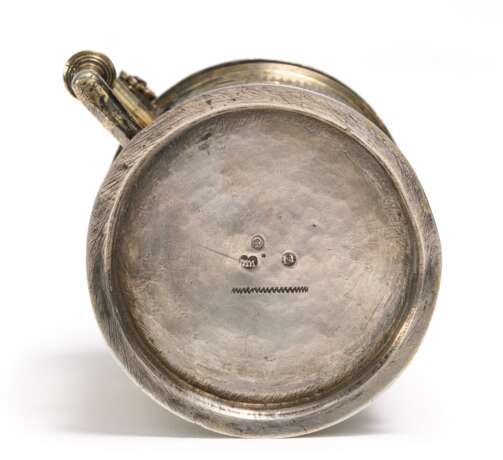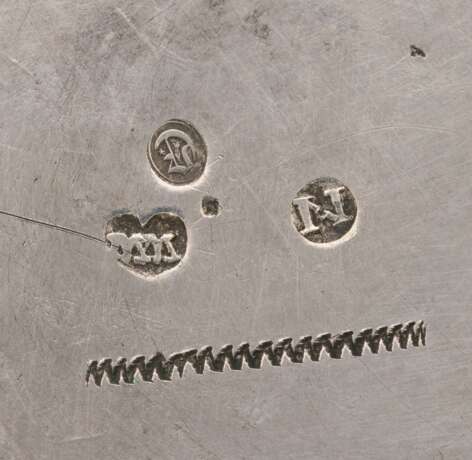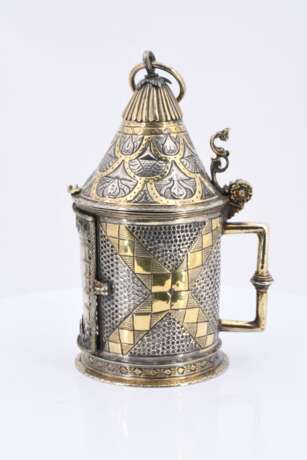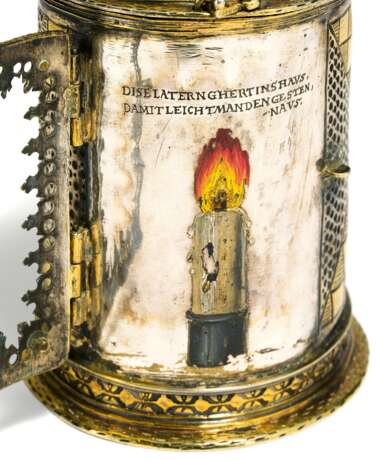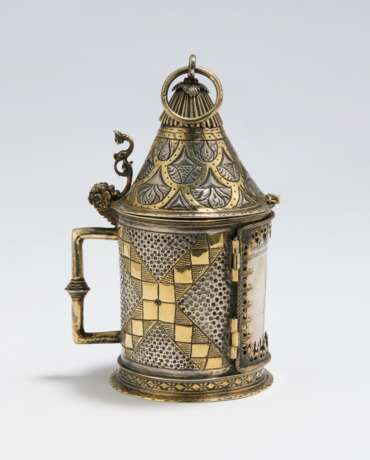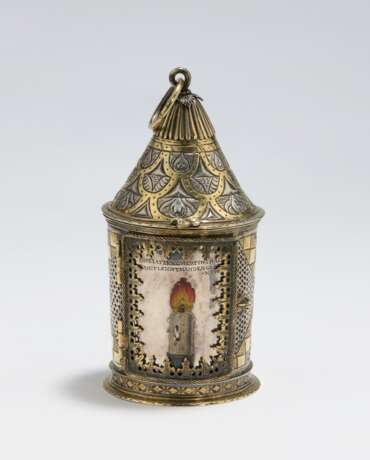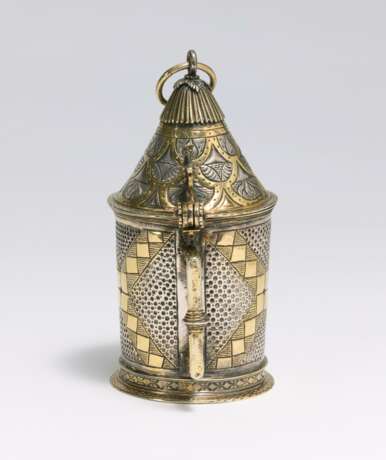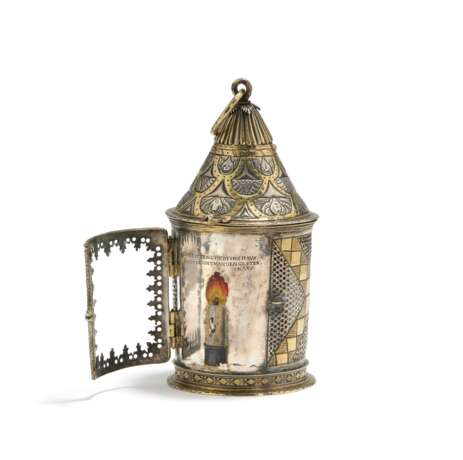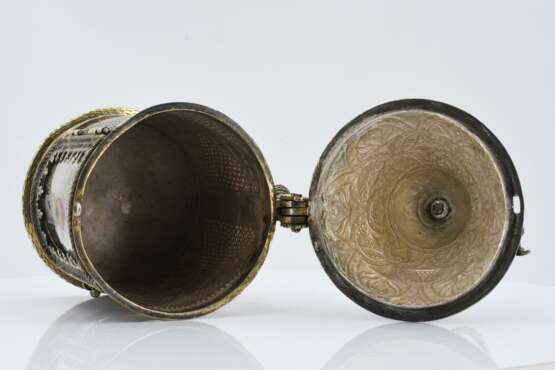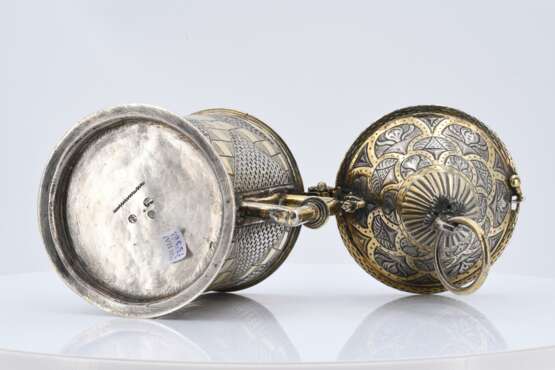ID 842023
Lot 84 | Rare lanternshaped tankard
Valeur estimée
€ 13 000 – 18 000
Müller, Michael. Nürnberg.
Date: 1632/37 - 1640/41.
Technique: Silver with gilt interior. Polychrome colors.
Description: Tankard in the shape of a small lantern with cylindrical wall on flat flared foot rim. The
cone-shaped lid on the back with rosette-shaped hinge and thumb rest in the form of
C-curves with a small woman's head. Small hinged clasp in the front. Rectangular handle
with stepped nodus. The body is decorated with ornamental decor in the form of a lying
cross on roughly punched ground. The lid with stylized shingle relief, topped by a
carrying hoop. In the front, centrally on the wall, a hinged and corded framing. Its inner
rim with sawn out leaf-shapes. Below the polychrome enamel painting of a burning candle.
Above the engraved motto "DIESE LATERN GHERT INS HAVS, / DAMIT LEICHT MAN DEN GESTEN NAVS".
Weight: Ca. 250g.
Measurement: Height 15,5cm, ø bottom 8cm.
Mark: Inspection mark Nuremberg (GNM no.15a), maker's mark Michael Müller (1612-1650, ibid. no.603b), test mark.
Belgian import stamps 1831-68 (Tardy p.86).
Literature:
- Bachtler, Monika, Syndram Dirk & Weinhold, Ulrike (eds.): Die Faszination des Sammelns - Meisterwerke der Goldschmiedekunst aus der Sammlung Rudolf-August Oetker, exhib.cat. Dresden and Munich September 21, 2011 to July 29, 2012, Munich 2011. On the subject of the lantern tankards, see pp.93ff. and p.105.
- Dresden State Art Collections, Weinhold, Ulrike, Witting, Theresa (eds.): Natürlich bemalt - Farbfassungen auf Goldschmiedearbeiten des 16. bis 18. Jahrhunderts am Dresdner Hof, Dresden 2018.
The tankard presented here is one of the few surviving examples of this particular type of vessel. Its shape is modeled after 17th century darklanterns. This illusion was to be further enhanced by the naturalistic depiction of the painted, burning candle in a tin-colored holder on the front. It is also possible that the small, hinged frame originally held some kind of membrane made of horn or parchment, as is the case with another Nuremberg lantern tankard in the collection of the Germanisches Nationalmuseum (Fascination (2011) p.93, fig.2).
The exact use of a lantern tankard is somewhat mysterious not only due to the small number of surviving pieces, but also for the lack of contemporary sources that would describe its exact purpose. However, the saying engraved above the candle, "DIESE LATERN GHERT INS HAVS, / DAMIT LEICHT MAN DEN GESTEN NAVS", (This lantern belongs inside the house, with it one shall show guests the way out) gives some indication of its function. First of all, based on this, one can safely assume that it was not a so-called "Willkomm", which was handed to the esteemed guest with a welcome drink upon arrival.
Rather, it seems to have been a humorous hint to said guest thata possibly wine-fueled evening was coming to an end. The tankard thus probably alludes to the custom of the time that a host should "light home" his guests by escorting them out of the house with a source of light (Faszination (2011) p.94f.).
The aforementioned tankard of the Germanic National Museum bears the same engraved inscription, but instead of a candle it shows the satirical engraved scene of a reveler in a wine cellar, thus supporting the assumption that the tankard served as a joke vessel.
Two other lantern tankards, from the Rudolf-August Oetker collection, can also be used for comparison. Especially the Nuremberg tankard by Esaias zur Linden, crafted around 1632, is very similar to our lantern tankard. Not only is the handle shape and the filigree thumb rest designed in the same manner, but the motto engraved inside the frame is also identical (Faszination (2011) p.105).
Overall it must be emphasized, how rare this lantern tankard by Michael Müller is and that it is a unique find which we are happy to beable to present to you here as part of our auction.
| Adresse de l'enchère |
VAN HAM Kunstauktionen GmbH Hitzelerstr. 2 50968 Köln Allemagne | ||||||||||||||
|---|---|---|---|---|---|---|---|---|---|---|---|---|---|---|---|
| Aperçu |
| ||||||||||||||
| Téléphone | +49 221 92586215 | ||||||||||||||
| Fax | +49 221 92 58 62 4 | ||||||||||||||
| Commission | 32% | ||||||||||||||
| Conditions d'utilisation | Conditions d'utilisation | ||||||||||||||
| Heures d'ouverture | Heures d'ouverture
|
